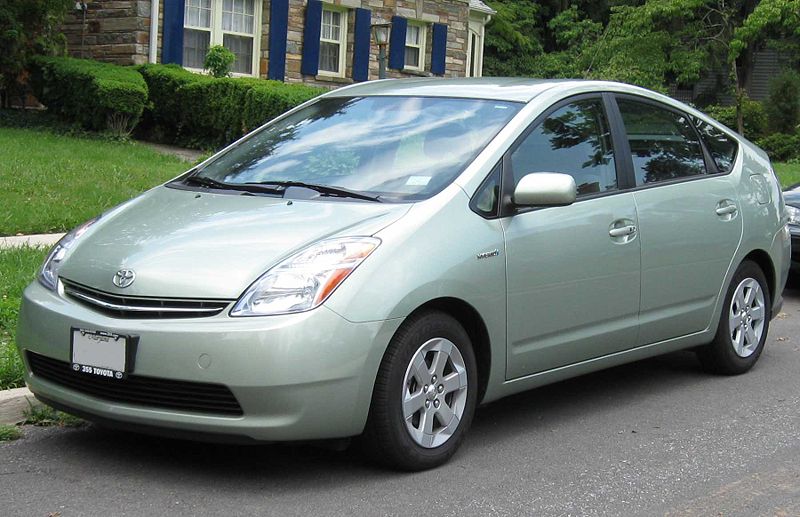|
Toyota Prius
The Toyota Prius is a hybrid car that runs on both gasoline and electricity. The Prius is the worlds most popular hybrid vehicle, with the Honda Civic Hybrid coming in second place. In 2007, Toyota sold 124,620 Prius Hybrids, which is 6 times more than Honda sold of their competing model. Approximately 1 in every 2 hybrid cars sold in the US is a Toyota Prius.

The Prius was first intruduced in Japan in 1997 and then released worldwide in 2001, being sold in more than 40 countries and regions with the largest markets being Japan and North America. According to the United States Environmental Protection Agency, the 2008 Prius is the most fuel efficient car sold in the US, although this is not the case in Europe, where in the UK there is 8 cars which are more efficient.
The Toyota Prius Compared To Other Hybrids
Motor Trend magazine compared the Prius with a Honda Civic Hybrid. The Prius had the better fuel efficiency by 3.9 mpg–U.S. (0.53 L/100 km / 4.7 mpg–imp), getting 43.8 mpg–U.S. (5.37 L/100 km / 52.6 mpg–imp) compared to 39.9 mpg–U.S. (5.9 L/100 km / 47.9 mpg–imp) for the Civic. In another comparison performed by Edmunds.com, the Prius got an extra 4.5 mpg–U.S. (0.50 L/100 km / 5.4 mpg–imp) at 48.3 mpg–U.S. (4.87 L/100 km / 58 mpg–imp).
The UK's Sunday Times paper however, compared the Prius with a BMW 520d SE that had a 132 kW diesel engine and regenerative braking, which averaged 50.3 mpg–imp (5.62 L/100 km / 41.9 mpg–U.S.) while the Prius only averaged 48.1 mpg–imp (5.87 L/100 km / 40 mpg–U.S.) over the same driving route. The comparison was performed on a trip of 545 miles (877 km) from London to Geneva, which included 100 miles (160 km) of urban driving, 200 miles (320 km) of driving on country roads, and about 200 miles (320 km) of highway driving at speeds of up to 78 miles per hour (126 km/h) on a French motorway. The BMW thereofore was more efficient than the Toyota Prius.
In the Popular Mechanics magazine diesel versus hybrid comparison of February 2005, the Prius performed better than the Volkswagen Jetta GL TDI diesel in both city and highway fuel economy.
Auto Express magazine also performed independent fuel efficiency tests, on public roads, on a number of hatchbacks, and in August 2007 published their list of the ten most efficient. The Prius achieved 10th place in the list, returning 41.5 mpg–imp (6.81 L/100 km / 34.6 mpg–U.S.). The Citroën C4 Coupé 1.6 HDi got 1st place with 49.6 mpg–imp (5.7 L/100 km / 41.3 mpg–U.S.).
The Prius was the overall number 1 of the Edmunds.com "Gas-Sipper Smackdown" fuel economy test, winning three of the five tests. The 2005 VW Jetta TDI won two of the tests. The other cars tested were the Smart Fortwo and the North American Ford Focus.
It is interesting to note that the Prius uses standard gasoline, while some other hybrids use diesel, which has a higher energy content, which could possibly expain the BMW 520d SE outperforming the Prius in the UK Sunday Times review.
How Does the Toyota Prius Hybrid Car Work?
The Toyota Prius uses a combination of gaslone and electric power to run the cars engines.
The electric power is stored in a closed cell 38-module nickel metal hydride (NiMH) battery pack providing 273.6 volts, 6.5 A·h capacity and weighs 53.3 kg, which is produced by Panasonic in Japan.
The battery is charged by the electric motor generators, which derive their energy from the kinetic energy of the brakes and also the gasoline engine. The gasoline engine is an A 1NZ-FXE internal combustion engine (ICE) using the Atkinson cycle, which is more efficient, instead of the more powerful Otto cycle. The gasoline engine normally turns off during traffic stops and the accessories (air conditioning, lights etc) are powered by the batteries. Because of the extra power available from the electric motors for rapid acceleration, the engine is smaller than usual for increased fuel efficiency and lower emissions with good acceleration.
The 2 electric motors in the car are generally used to accelerate the car up to about 1540 rpm, which is when the gasoline engine starts to work.
Normal gasoline powered cars are the most inefficient in city driving because a lot of power is lost through the constant starting and stopping of the vehicle. Fuel is used while the car is idle, fuel is then used to accelerate the car, and then all that energy is lost when the car brakes again. The hybrid car however captures some of this energy that is lost when braking through its regenerative braking technology, which uses the electric generators to slow the car whilst stroring the generated power in the batteries, which is then used to power the electric motors to get the car moving again. Most gasoline engines are more efficient after 1400 rpm, so the electric motors do most of the work up till then. Therefore the Prius obtains much of its advantages over ordinary cars during city driving.
Extra efficiency is also derived during highway driving because the gasoline engine used is smaller than that of a non-hybrid car of the same class. This is made possible, because ordinary gasoline engines are much larger than necesarry because of the extra size needed to accelerate the car from a standstill, which is performed on the Prius by the elctric motors.
|
|

